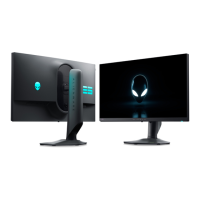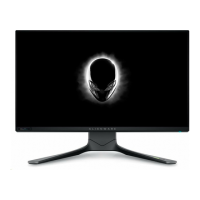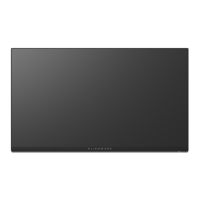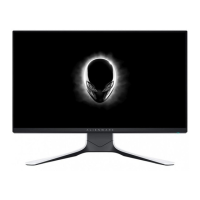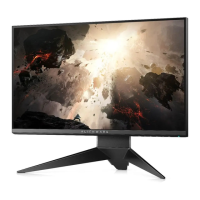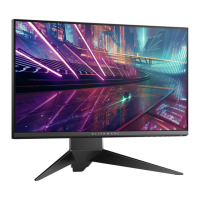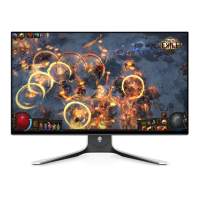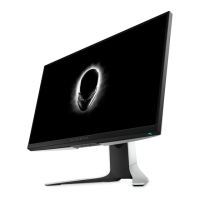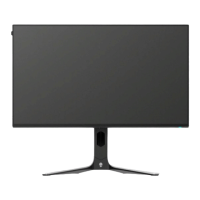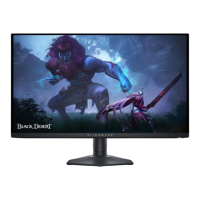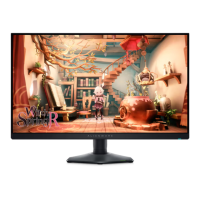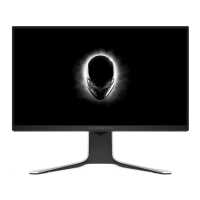Do you have a question about the Alienware AW2524HF and is the answer not in the manual?
Lists components included with the monitor, noting some may be optional.
Highlights the key capabilities and technologies of the monitor, including display specs and connectivity.
Identifies controls, ports, and slots located on the monitor's front panel.
Identifies ports, VESA mounting holes, and cable management slots on the monitor's back.
Details various ports and connectors located on the rear and bottom of the monitor.
Details supported display resolutions, horizontal/vertical scan ranges, and pixel clock frequencies.
Lists the video display capabilities for DisplayPort and HDMI inputs.
Table showing timing parameters for various DisplayPort resolutions.
Table showing timing parameters for various HDMI resolutions.
Provides details on video input signals, power consumption, and inrush current.
Outlines monitor dimensions, weight, and border width.
Specifies operating temperature, humidity, altitude, and compliant standards.
Pinout diagram and descriptions for the 20-pin DisplayPort connector.
Pinout diagram and descriptions for the 19-pin HDMI connector.
Information on USB transfer speeds and upstream/downstream connector pinouts.
Instructions and precautions for safely cleaning the monitor's screen and chassis.
Step-by-step guide for assembling and securely attaching the monitor stand.
General instructions for connecting the monitor to a computer and peripherals.
Illustrates how to connect using DisplayPort and USB cables.
Illustrates connecting via USB-C to DisplayPort and USB cables.
Illustrates connecting using HDMI and USB cables.
Guidance on using the monitor's cable management features for neat routing.
Instructions for using a security lock to prevent theft or unauthorized movement.
Steps for safely detaching the monitor stand from the display.
Guidance on mounting the monitor using a VESA-compatible wall bracket.
How to navigate and use the monitor's joystick control for OSD adjustments.
Guide to accessing and navigating the monitor's OSD settings for configuration.
Details specific settings for optimizing the gaming experience with consoles via HDMI.
Explains common warning messages displayed on the OSD and their meaning.
How to lock or unlock the monitor's OSD menu and power buttons.
Steps to configure the monitor's highest supported display resolution via system settings.
Information on necessary hardware and software for HDR content.
Instructions for adjusting the monitor's tilt and swivel angles for optimal viewing.
Instructions for adjusting the monitor's vertical height using the stand.
Instructions for rotating the monitor display from landscape to portrait orientation.
How to configure display rotation via operating system graphics settings.
Guide to customizing visual modes and effects for enhanced gaming scenarios.
Details on configuring gaming-specific features like Dark Stabilizer and Response Time.
Instructions for adjusting general display settings like brightness, contrast, and preset modes.
Procedure for running the monitor's built-in diagnostic to check functionality.
Lists typical monitor issues and provides their possible solutions.
Troubleshooting steps for common issues related to USB interface functionality.
Information on compliance and regulatory notices for the US market.
Link to the EU's EPREL database for energy efficiency information.
Information on how to reach Dell for sales, technical support, or customer service.
Lists components included with the monitor, noting some may be optional.
Highlights the key capabilities and technologies of the monitor, including display specs and connectivity.
Identifies controls, ports, and slots located on the monitor's front panel.
Identifies ports, VESA mounting holes, and cable management slots on the monitor's back.
Details various ports and connectors located on the rear and bottom of the monitor.
Details supported display resolutions, horizontal/vertical scan ranges, and pixel clock frequencies.
Lists the video display capabilities for DisplayPort and HDMI inputs.
Table showing timing parameters for various DisplayPort resolutions.
Table showing timing parameters for various HDMI resolutions.
Provides details on video input signals, power consumption, and inrush current.
Outlines monitor dimensions, weight, and border width.
Specifies operating temperature, humidity, altitude, and compliant standards.
Pinout diagram and descriptions for the 20-pin DisplayPort connector.
Pinout diagram and descriptions for the 19-pin HDMI connector.
Information on USB transfer speeds and upstream/downstream connector pinouts.
Instructions and precautions for safely cleaning the monitor's screen and chassis.
Step-by-step guide for assembling and securely attaching the monitor stand.
General instructions for connecting the monitor to a computer and peripherals.
Illustrates how to connect using DisplayPort and USB cables.
Illustrates connecting via USB-C to DisplayPort and USB cables.
Illustrates connecting using HDMI and USB cables.
Guidance on using the monitor's cable management features for neat routing.
Instructions for using a security lock to prevent theft or unauthorized movement.
Steps for safely detaching the monitor stand from the display.
Guidance on mounting the monitor using a VESA-compatible wall bracket.
How to navigate and use the monitor's joystick control for OSD adjustments.
Guide to accessing and navigating the monitor's OSD settings for configuration.
Details specific settings for optimizing the gaming experience with consoles via HDMI.
Explains common warning messages displayed on the OSD and their meaning.
How to lock or unlock the monitor's OSD menu and power buttons.
Steps to configure the monitor's highest supported display resolution via system settings.
Information on necessary hardware and software for HDR content.
Instructions for adjusting the monitor's tilt and swivel angles for optimal viewing.
Instructions for adjusting the monitor's vertical height using the stand.
Instructions for rotating the monitor display from landscape to portrait orientation.
How to configure display rotation via operating system graphics settings.
Guide to customizing visual modes and effects for enhanced gaming scenarios.
Details on configuring gaming-specific features like Dark Stabilizer and Response Time.
Instructions for adjusting general display settings like brightness, contrast, and preset modes.
Procedure for running the monitor's built-in diagnostic to check functionality.
Lists typical monitor issues and provides their possible solutions.
Troubleshooting steps for common issues related to USB interface functionality.
Information on compliance and regulatory notices for the US market.
Link to the EU's EPREL database for energy efficiency information.
Information on how to reach Dell for sales, technical support, or customer service.
| Screen Size | 24.5 inches |
|---|---|
| Panel Type | IPS |
| Brightness | 400 cd/m² |
| Contrast Ratio | 1000:1 |
| Aspect Ratio | 16:9 |
| Color Gamut | 99% sRGB |
| Resolution | 1920 x 1080 |
| Viewing Angle | 178° (horizontal), 178° (vertical) |
| VESA Mount | 100 x 100 mm |
| Adaptive Sync | AMD FreeSync Premium, NVIDIA G-SYNC Compatible |
| Response Time | 0.5 ms (Gray-to-Gray min) |
| Connectivity | HDMI, DisplayPort, USB |
